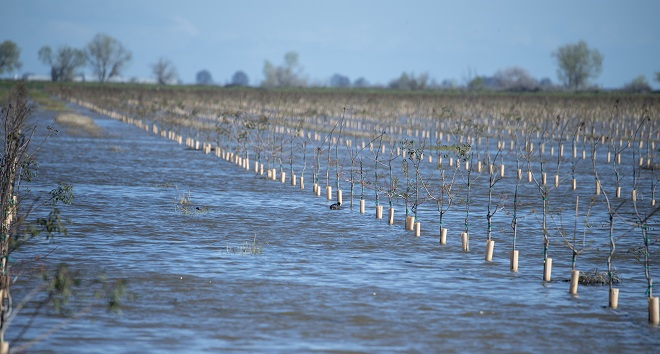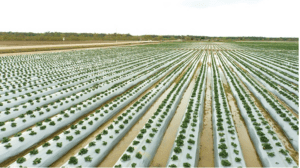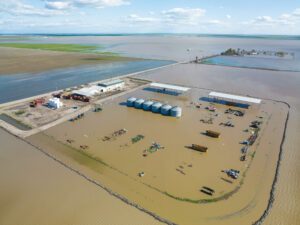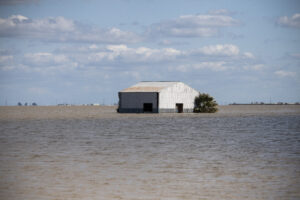

May 22, 2023Pest, disease damage expected, harvest impacts uncertain
The seemingly unending flow of water saturating their fields is burdening California growers with pests and diseases.
In March and continuing into April and later, torrential rains and multiple “atmospheric rivers” swept across the state, dumping rain throughout the Golden State from Southern California to the northern regions.


“If we’re not in a drought, we’re drowning,” said Juan Hidalgo, agricultural commissioner for Monterey County. “Certainly, this year has really been hard for a lot of our counties.”
Driving rains formed a cloud of uncertainty over growers, who remain uncertain how the disastrous weather could affect their crops. With ground underwater, water must be tested for safety and equipment becomes disabled. Many growers’ wells became plugged from not pumping water.
If rain forecasts hold, growers could experience planting gaps into July.
“I’ve never seen anything like this in my whole life,” said Dick Peixoto, founder and owner of Watsonville’s Lakeside Organic Gardens, which grows a variety of organic leafy greens and other vegetables.
In January, Lakeside only saw three days without rain. Greenhouse transplants aged during the rain delays, requiring hand planting of lettuce. The company lacked dry ground for planting.
“It’s just compounding. It’s pretty grim,” he said.
Peixoto predicts crop shortages and hit-and-miss harvesting through the summer.
Testing the water
Floodwater can contain heavy metals and other unknown elements, requiring testing.
“There will be a lot more critique because of food safety issues as far as being flooded with the water’s unknown source,” Peixoto said. “It will be a bigger issue this year. Everyone’s going to have to watch what steps they take to handle them.”
With berries underwater in areas in the Salinas Valley, the standing water could cause problems on heavier soils that don’t drain well or on wider pieces of ground, said Paul Pezzini of Pezzini Berry Farms in Salinas.
In the long term, Pezzini foresees an increase in disease and weed pressure. Growers can expect more botrytis. Some of the diseases that normally appear later in the season could create headaches earlier than usual.
This water could bring soil disease and that kind of thing, which is always a problem,” he said.


Plant diseases favor heavy moisture, said Gerald Holmes, director of the Cal Poly Strawberry Center in San Luis Obispo.
“Diseases love water,” he said. “Most diseases thrive in wet conditions. Rain splashes fungal spores around. Most diseases are worse when there’s a lot of moisture.”
Holmes said phytophthora root rot revels in wet conditions. He said growers should prepare for more incidences of those diseases and other fungal pathogens, including botrytis rot on fruit, a common disease that worsens during rain, and angular leaf spot, a bacterial disease on foliage.
“It’s really difficult for growers to treat disease when it’s raining because they can’t get their rigs into the fields,” Holmes said. “They have had so much rain. We expect a lot of losses will be due to botrytis.”
Pollination fears
Honeybees don’t like to fly in unfavorable weather, concerning growers about how the torrential rains will affect pollination.
“As we have had a lot of days where it was either raining or too cold or too windy, whether we get a good pollination job or not is questionable,” said Joe Del Bosque, CEO/operations of Del Bosque Farms, Firebaugh, which grows melons, almonds and cherries.
He said “storm after storm” continued throughout the bloom season.
“The bees have only been able to come out every several days,” Del Bosque said. “Other times, there may be one storm during the bloom seasons. It may affect us, but we probably had fewer good pollination days this season than others.”


In early May, government damage estimates weren’t available, but Moody’s RMS, a catastrophe risk modeling and solutions firm, estimated total U.S. economic losses from the California floods at $5 billion to $7 billion. The estimate includes infrastructure damage.
The state is working closely with local county officials as well as the USDA to tally the extent of damage and to bring aid to farmers, ranchers and landowners who have been affected by the flooding, said Brian Ferguson, deputy director of the California Governor’s Office of Emergency Service.
“The flooding, particularly in the Central Valley, is very much an ongoing and evolving challenge,” he said. “Work is happening rapidly on the ground now to get clarity on impacts, and we are likely to have a much clearer picture in the weeks and months to come as the water recedes.”
During an April 5 California State Board of Food and Agriculture meeting, Asha Raj, emergency management coordinator with the California Department of Food and Agriculture, said the agency is coordinating and sharing information with county ag commissioners in the flood-affected counties and working with trade associations.
“We are working with ag commissioners to gather crop loss information to get a USDA designation,” she said.
— Doug Ohlemeier, assistant editor
Top photo: Flooded fields in Tulare County, in the Central Valley. Photo courtesy California Department of Water.
Second photo: California farms were jeopardized by torrential rains that deluged fields, like this strawberry field near Salinas. Photo courtesy California Strawberry Commission.
Third photo: An extended period of rain is expected to bring more pests and disease to California fields. Growers and agencies were uncertain of how the difficult weather would affect harvesting. Photo courtesy California Department of Water.
Bottom photo: Floodwaters damaged fields and property south of Corcoran, in Kings County, in this late March photo, courtesy California Department of Water Resources.














